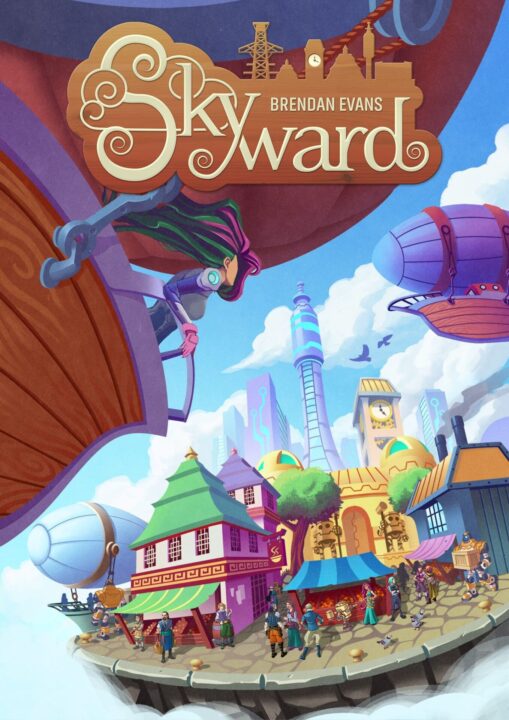Alright folks, gather ’round because it’s time for another board game review, and this time I’m cracking open a box that promises sky-high strategy and a fair shot for everyone at the table. Yup, I’m talking about a game that somehow mixes card drafting, clever splitting, sneaky player moves, smart balance, and really eye-catching art—plus, it did not make me flip the table in rage (which my friends say is a Christmas miracle). So, is this game the ticket to tabletop joy, or just hot air? Read on and find out.
How It Plays
Setting Up
First, spread out the board and give each player a starting faction. Shuffle the deck of buildings and deal out cards for the first split. Everyone grabs their cute little airships and a set of tokens. Put the resources in reach, unless your cat is sitting there, then good luck.
Gameplay
Each round, the “Warden” splits the cards into piles. Everyone else picks a pile to take (and the Warden gets what’s left, so don’t get greedy). Use your cards to build stuff in your sky city, pay with resources, and try to trigger cool abilities. There’s plenty of tension and side-eye as you guess what people want most. Repeat this whole process until the deck runs out.
Winning the Game
Once the last round wraps up, everyone adds up their points from built cards and bonuses. Whoever’s city looks the prettiest on paper (a.k.a has the most points) wins. If you tie, just arm-wrestle or have a staring contest, like my friends did (it was epic).
Want to know more? Read our extensive strategy guide for Skyward.
The Joy (and Pain) of Card Drafting and Splitting in Board Games
I have a love-hate relationship with card drafting games. You know, those games where you pick a card and pass the rest, like speed dating for indecisive people. “Skyward,” however, throws a wrench into the usual formula with its splitting mechanic. If you’ve never played, imagine you’re slicing a birthday cake, but your friends will snatch slices before you even pick. That’s what “Skyward” does. One player splits the pile of cards into groups, but they pick last. The rest of us stare and giggle as the splitter sweats, trying to guess what we’ll take. It feels a bit like psychological warfare, but with less yelling and more polite sighs.
This mechanic brings a delicious tension to the game. I’ve tried to trick my friend Becky by putting all the good stuff in one pile, hoping she’d be greedy, but she just grinned and took the less obvious, sneakier choices. Skyward rewards cunning, not just luck. You have to read your tablemates like a cheap novel. It isn’t just about grabbing the best card. It’s about thinking three moves ahead, or at least pretending you did when your plan goes completely sideways.
Card splitting in “Skyward” makes every choice count, and stops one lucky person from running away with the game. It also sparks all sorts of silly arguments about what’s “fair.” Skyward proves that sometimes, splitting up really is hard to do.
Next, let’s see how these clever choices play out when the competition heats up—player interaction is where things really get spicy!
Player Interaction and Competition in Skyward
When it comes to player interaction, Skyward had my game group trading snarky comments and side-eye all night. This is not a game for the shy or mild-mannered. You have to keep one eagle eye on your opponents — and the other on your own growing city in the clouds. In Skyward, a lot of the action happens right in the open. You see every card everyone plays, and you always know who’s chasing the same objectives as you. That means you’ll probably have to dash a few hopes to get ahead.
Skyward pours gasoline on the competition by giving everyone overlapping goals. Want to complete a district before your neighbour? You’ll need to snag that card first, and they know it. Drama! More than once, my friend Sam grumbled, “Why’d you take the Observatory?” I think his eye twitched a bit. And don’t even get me started on the race to claim the best abilities. Sometimes, it feels like you’re all elbowing your way through a crowded market — polite, but definitely willing to knock over someone’s fruit cart if it means winning.
I love that Skyward forces you to pay attention to your rivals and adjust your plans. You can’t just play solo and hope for the best. Being aware of who’s leading and who’s lagging keeps the tension high all game long.
And now, let’s take a turbulent leap into the next section: Game balance and fairness—because what’s a competition without a level playing field?
Skyward Game Balance and Fairness: Is Everyone Really on Equal Ground?
The eternal struggle in board games: does everyone really have a fighting chance? In Skyward, I had to look closely at how the game treats all players. I’ve seen games where my friend Andrew pulls ahead while the rest of us just munch snacks and sulk, but in Skyward, it actually feels a bit more even. The rules force you to make tough choices, but you usually have the chance to bounce back if you make a mistake or get unlucky. No one was left out in the cold after a rough round—unless, of course, they refused to listen to me (which, to be fair, happens a lot).
What really surprised me was how each faction’s abilities felt balanced. You won’t find one player steamrolling everyone just because they got lucky with a single combo. True, you can get some sweet synergy if you plan ahead, but it doesn’t break the game. Everyone gets their shot at glory, which kept our group invested right to the end. Even our eternal sulker, Dave, couldn’t blame his defeat on the game. I won’t say there’s zero luck, but most of your victory hinges on your brain, not the luck of the draw. This fairness kept the table friendly and, most importantly, let me gloat when I actually won with skills, not just fortune.
But before you think I’m all business, next up I’ll rave, rant, and raise an eyebrow over Skyward’s artwork and component quality—so prepare your eyeballs for some cardboard beauty (or beastliness)!
Skyward Board Game: Artwork and Component Quality Review
If you ever wanted to play a game that looks like it fell out of a steampunk dream, Skyward fits the bill. The very first time I set it up on my kitchen table, my friend Claire squealed, “Ooo, pretty!”—and let me tell you, she is not one to exaggerate unless there’s cake around.
The cards in Skyward feature airships, floating cities, and all sorts of quirky contraptions. The art style is bold and vibrant, with lots of little details hiding in the backgrounds. I found myself picking up cards just to admire the clouds and gears, which was a new low for my attention span during a game. The color palette is bright but not blinding. Even my color-blind mate Dave had no trouble telling cards apart, which is a huge plus.
Now, let’s talk bits and pieces. The cards themselves are thick and don’t bend easily (unless you get butter on them—looking at you, Phil). The tokens have fun shapes and solid heft, so they’re nice to fiddle with while you pretend to ponder your next draft. The insert in the box keeps everything tidy, which is a small miracle in the world of board games, where half the time you need a degree in engineering just to put things away.
All in all, Skyward nails the look and feel. If you like gorgeous components and sturdy cards, you’ll be very happy here. Would I recommend Skyward based on the artwork and component quality alone? Absolutely. It’s eye-candy for your tabletop without feeling flimsy or cheap. Next, let’s see if the gameplay lives up to the packaging…
Conclusion
So there you have it, folks. Skyward is a smart, fast-paced card game with some of the best “I split you choose” moments I’ve seen. It kept my friends talking for days about who got the best airship or who ruined the marketplace (it was Mike. It’s always Mike). The art is lovely, the components are solid, and luck doesn’t rule the day—you need a brain, not just a lucky shuffle. While it won’t make you rich in airships, it will leave your game night crew smiling (and maybe plotting revenge). If you want a game that’s fair, tense, and just the right amount of mean, Skyward soars above the rest. That’s a wrap on this review—see you next time, and may your airships never crash!


